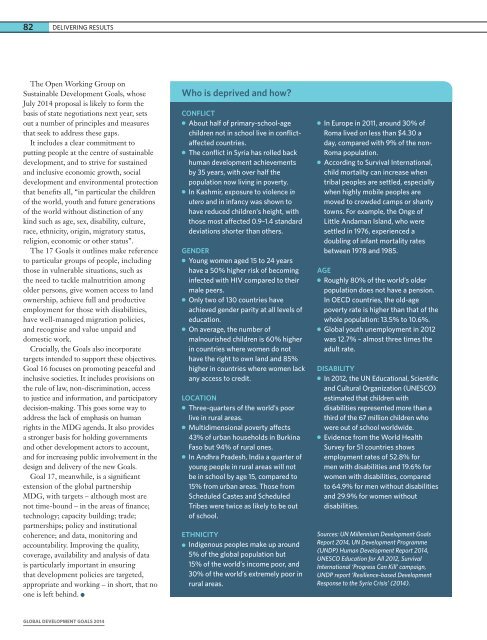FAMBB
FAMBB
FAMBB
You also want an ePaper? Increase the reach of your titles
YUMPU automatically turns print PDFs into web optimized ePapers that Google loves.
82 DELIVERING RESULTSThe Open Working Group onSustainable Development Goals, whoseJuly 2014 proposal is likely to form thebasis of state negotiations next year, setsout a number of principles and measuresthat seek to address these gaps.It includes a clear commitment toputting people at the centre of sustainabledevelopment, and to strive for sustainedand inclusive economic growth, socialdevelopment and environmental protectionthat benefits all, “in particular the childrenof the world, youth and future generationsof the world without distinction of anykind such as age, sex, disability, culture,race, ethnicity, origin, migratory status,religion, economic or other status”.The 17 Goals it outlines make referenceto particular groups of people, includingthose in vulnerable situations, such asthe need to tackle malnutrition amongolder persons, give women access to landownership, achieve full and productiveemployment for those with disabilities,have well-managed migration policies,and recognise and value unpaid anddomestic work.Crucially, the Goals also incorporatetargets intended to support these objectives.Goal 16 focuses on promoting peaceful andinclusive societies. It includes provisions onthe rule of law, non-discrimination, accessto justice and information, and participatorydecision-making. This goes some way toaddress the lack of emphasis on humanrights in the MDG agenda. It also providesa stronger basis for holding governmentsand other development actors to account,and for increasing public involvement in thedesign and delivery of the new Goals.Goal 17, meanwhile, is a significantextension of the global partnershipMDG, with targets – although most arenot time-bound – in the areas of finance;technology; capacity building; trade;partnerships; policy and institutionalcoherence; and data, monitoring andaccountability. Improving the quality,coverage, availability and analysis of datais particularly important in ensuringthat development policies are targeted,appropriate and working – in short, that noone is left behind.Who is deprived and how?CONFLICT●●About half of primary-school-agechildren not in school live in conflictaffectedcountries.●●The conflict in Syria has rolled backhuman development achievementsby 35 years, with over half thepopulation now living in poverty.●●In Kashmir, exposure to violence inutero and in infancy was shown tohave reduced children’s height, withthose most affected 0.9–1.4 standarddeviations shorter than others.GENDER●●Young women aged 15 to 24 yearshave a 50% higher risk of becominginfected with HIV compared to theirmale peers.● ● Only two of 130 countries haveachieved gender parity at all levels ofeducation.● ● On average, the number ofmalnourished children is 60% higherin countries where women do nothave the right to own land and 85%higher in countries where women lackany access to credit.LOCATION●●Three-quarters of the world’s poorlive in rural areas.●●Multidimensional poverty affects43% of urban households in BurkinaFaso but 94% of rural ones.● ● In Andhra Pradesh, India a quarter ofyoung people in rural areas will notbe in school by age 15, compared to15% from urban areas. Those fromScheduled Castes and ScheduledTribes were twice as likely to be outof school.ETHNICITY●●Indigenous peoples make up around5% of the global population but15% of the world’s income poor, and30% of the world’s extremely poor inrural areas.●●In Europe in 2011, around 30% ofRoma lived on less than $4.30 aday, compared with 9% of the non-Roma population.● ● According to Survival International,child mortality can increase whentribal peoples are settled, especiallywhen highly mobile peoples aremoved to crowded camps or shantytowns. For example, the Onge ofLittle Andaman Island, who weresettled in 1976, experienced adoubling of infant mortality ratesbetween 1978 and 1985.AGE● ● Roughly 80% of the world’s olderpopulation does not have a pension.In OECD countries, the old-agepoverty rate is higher than that of thewhole population: 13.5% to 10.6%.●●Global youth unemployment in 2012was 12.7% – almost three times theadult rate.DISABILITY●●In 2012, the UN Educational, Scientificand Cultural Organization (UNESCO)estimated that children withdisabilities represented more than athird of the 67 million children whowere out of school worldwide.●●Evidence from the World HealthSurvey for 51 countries showsemployment rates of 52.8% formen with disabilities and 19.6% forwomen with disabilities, comparedto 64.9% for men without disabilitiesand 29.9% for women withoutdisabilities.Sources: UN Millennium Development GoalsReport 2014, UN Development Programme(UNDP) Human Development Report 2014,UNESCO Education for All 2012, SurvivalInternational ‘Progress Can Kill’ campaign,UNDP report ‘Resilience-based DevelopmentResponse to the Syria Crisis’ (2014).GLOBAL DEVELOPMENT GOALS 2014


